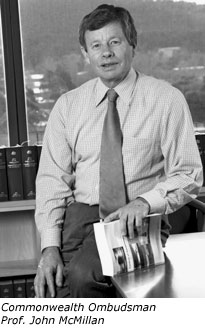Commonwealth Ombudsman Annual Report 2004-05 | Foreword


FOREWORD
 This has been a year of change in the Ombudsman's office. New functions, new programs and new work practices have been key activities during the year. Each of those changes tells a larger story about the developing role of the Ombudsman.
This has been a year of change in the Ombudsman's office. New functions, new programs and new work practices have been key activities during the year. Each of those changes tells a larger story about the developing role of the Ombudsman.
One of the new functions conferred by the Surveillance Devices Act 2004 is to conduct a periodic inspection of the records that law enforcement authorities are required to compile when using surveillance devices in criminal investigations and in other specifically defined circumstances. A similar new function conferred by the Workplace Relations Act 1996 is to conduct an annual inspection of the records of the Building Industry Taskforce, concerning its exercise of coercive powers to inspect building and industrial activity in Australia.
These functions add to an existing role of the office in inspecting law enforcement records relating to telecommunications interceptions and controlled operations. Compliance auditing has now developed as a distinct third function of the office, in addition to its traditional functions of complaint investigation and own motion investigations. The record inspection function of the office is an important mechanism for ensuring compliance with statutory procedures that exist as a safeguard for members of the public. The office has responded to this new responsibility by establishing an inspections team, developing manuals and guidelines for the inspection function, and holding an annual symposium of Commonwealth and State agencies performing a similar function.
Another new function of the office is to assess the situation of long-term immigration detainees and to report to the Parliament. The heightened new role of the office in oversighting immigration administration was formalised by a government announcement that legislation would be introduced late in 2005 to confer upon the office the title of 'Immigration Ombudsman'. This is now one of several special titles held by the Commonwealth Ombudsman—Taxation Ombudsman, Defence Force Ombudsman, Australian Capital Territory Ombudsman, and (foreshadowed) Postal Industry Ombudsman.
This trend portrays an intricacy now required of a modern ombudsman's office. There is, on the one hand, a public expectation that in selected areas of government that fall under the spotlight of public accountability, an oversight body will bring to that role a distinctive profile and a specialised understanding of the area being monitored. On the other hand, an established oversight body with a generalist function has much else to offer: in the case of my own office, an office in each State and Territory, an outreach program, experience in complaint investigation, a large staff with a diversity of skills, sufficient resources to deal with fluctuations in complaint work, statutory powers, and tradition and visibility. In short, a modern ombudsman's office can be a generalist agency, hosting a cluster of specialties.
'This trend portrays an intricacy now required of a modern ombudsman's office.'
The specialised role of the office in immigration, defence, taxation and other areas of government has been significant in the past year in another way. It has required us to address a difficult and important question. If it is expected of an ombudsman's office that it can make a difference—assisting people to resolve complaints, correcting defective administration, and fostering good public administration—how can that best be done in a system of government that is large, complex, geographically dispersed, and that far overshadows in size and resources the body oversighting it?
Our response, after a year of reflection and planning, will be a sweeping change to the way that complaints are handled and investigated. One aspect of that change is the formation of a Public Contact Team in Canberra that will receive and evaluate the tens of thousands of complaints and inquiries that come to the office each year. The investigation staff located in eight separate offices around Australia will then be able to focus in a more targeted way on two important dimensions of each complaint: the practical remedy needed to resolve a grievance, and systemic problems in public administration that require more attention. To accommodate these and other work practice changes, the office is currently changing its computerised complaints management system, its investigation procedures, and its recording systems.
Two other programs for which special funding was received in the past year also point to a new direction in the office. One is an outreach program to rural and regional Australia, with a particular emphasis on making the Ombudsman's office better known to community support groups and parliamentary electorate offices. The other program is an international regional support network being developed among ombudsman offices in Australia, Asia and the Pacific. Both programs illustrate larger themes in the work of the office: that the right to complain should be enjoyed locally, nationally and internationally; and that principles of good government are universal in character.
These and other changes described in this report exemplify an adaptability and flexibility in the Ombudsman model that are a key to its continued relevance and success. The cover to this report has been chosen to capture that spirit and illustrate in a pictorial manner that change can be perceptible yet seamless.
Prof. John McMillan
Commonwealth Ombudsman
